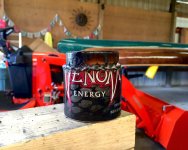Mr Hoop, I have some questions.
What do you think of the Chimney Jet design? Did you sell your stainless Clikstand? I looked at the Trangia Triangle as opposed to the Clikstand and opted for the Clikstand because of the little tabs to hold the windscreen, thus allowing air to flow under the screen and feed the stove. Does your Foil widescreen work the same way, that is does it sit on the clikstand tabs? I do know that you can make simmer ring for homemade stoves depending on the design but do confess none of them looked as slick and well designed as the Trangia.
Let me add too that I think the entire Trangia set-up with the stand pots and everything else looks like an incredible slick set up. Completely nesting and a complete unit. I am super happy with my Optimus Nova plus but it doesn't pack well. I always fear crushing it and bending a piece that sticks out.
Hi RL. I watched the video on the chimney jet design, which is the first time I had seen that, so I cannot comment knowledgably about it. It did not look like it can simmer with any sort of adapter? I hope the maker of those sends one to Hiram Cook to test! The video showed 400 ml boiling in 3.5 minutes. Hiram's standard test is 2 US cups, which is 473 ml. Hiram also uses a start temp of 60F, and records his ambient temp as well. The chimney jet video did not state what the starting water temp was? Adding 73 ml might take it closer to 4 minutes. Hiram has achieved boils with various stove combos close to 4 minutes. Many good stoves are closer to 5-6 minutes in his standard tests. A Trangia burner in the right stove set up can achieve boils in about 4 minutes, and my rough non-standardized home tests on my Trangia and Clickstand and Ti pots, without knowing starting water temp (cold water out of the tap), achieve about 6 minutes boil with 2 cups or 500 ml. I am not concerned about the 2 extra minutes from the best time possible. I think a minute or two difference is also based on pot bottom size and shape, and metal material. The pots I use now are Ti, and they are probably not as fast boiling as the anodized aluminum kettle used on the chimney jet video.
Another issue is durability and packability. That chimney jet looks kinda fragile? It is made of an aluminum drink can. If it got banged or stepped on, or crushed against other stuff in a pack that is dropped on a portage, would it still work? The Trangia is a good hunk of brass that can take abuse.
I have not sold my SS Clikstand yet. I sort of forgot. I need to post up that sale. On my Ti Clickstand I still use its Ti windscreen for my small "tall" pots, and its very convenient and super light (21 g on my scale). However I find myself using the ground based (sits on the ground) Primus foil windscreen (61 g) more now since I carry it anyways for using my frypan on the Clickstand because of the extra girth needed, so no need for me to carry two windscreens anymore. You leave one side open and there is plenty of air that can come in through the gap. On a backpacking trip where I do not have a frypan, I would stick with the original Ti windscreen for sure.
I have not used the full Trangia pot system with windscreen. It is of course used and loved all over the world. However my pot set must be able to be used on open fire, and my pots must have bail handles (for hauling water up steep banks, and hanging pots off sticks over a fire, etc), and deep dish lids with handles that also serve as dishes to eat out of, or fry with. My fry pan must have a fold out permanent handle for using on a fire grate or on logs/coals with gloved hands and sticks. Pot grippers and pots and pans without permanent handles are not for me. Therefore my style of tripping is not conducive to using the full Trangia pot and windscreen design, and I found the Clickstand plus windscreen serves the pot/pan support function nicely with a low weight and packs super compact. However if I did not use fire and used only a stove, I would for sure purchase the full Trangia kit in the solo hard anodized series (27 HA series), see link:
http://www.trangia.se/english/5615.27_series_ul_ha.html
There is a gas burner accessory for using the Trangia wind screen system with either white gas or isobutane, so its very versatile. Maybe a tad heavy for backpacking, but fine for canoe tripping.
I think you made a good choice with the Clikstand. The area inside is wide enough to extend the simmer ring in a full range. I also bought the wire insert adapter for the Evernew Ti burner (or you could make one easy), and I know the Trangia simmer ring can work on the Evernew, which makes for a lighter option. I have not used the Trangia triangle so don't know what kind of range it has, but its not in Ti, and I have concluded that I am old enough now to deserve Ti gear! (Time for me to buy a Ti woodstove for winter hot tenting!). Having looked at The Esbit triangle on videos, it looks rather small to allow full range of movement for the simmer ring, although I have not used it. That simmer capability for me is essential for my cooking.

